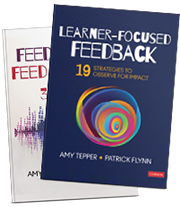Doing it right means so much more than getting it right. A lesson we have learned working with evaluators across the country, especially with teacher evaluations. At ReVision Learning we know the challenges of observing teachers, collecting evidence, and analyzing our notes against attributes and frameworks. We realize then taking all of this information and translating into evidence based feedback statement is a highly challenging endeavor.
For the last two years ReVision Learning has toiled away on a system to meet this challenge. We wanted to create a model for feedback or, better put a thinking frame evaluators could utilize to organize and deliver essential information to teachers.
From this work, and with a nod to Jon Saphier for his inspiration, came ReVision Learning’s Claim, Connect, Action – a simple and direct model of structuring feedback to teachers.
Evaluators employing the Claim, Connect, Action learn to make claims against specific attributes, connect those claims to observed feedback, and provide actionable feedback using the key levers in a chosen framework.
Jeff Wallowitz, Principal of Webster Elementary School in West Hartford CT worked with ReVision Learning to employ Claim, Connect, Action for the past year. Jeff notes:
Through all my work and professional development with ReVision Learning, one area stands out as having the greatest impact on my ability to provide meaningful and effective feedback to teachers. As “Claim, Connect, Action” became more clear to me, I began to feel its profound impact on all teachers and not just the professionals who had an area that fell in the “developing” range.
The Claim

flickr photo shared by cogdogblog under a Creative Commons ( BY ) license
At its heart observational based feedback begins with a claim. A statement that we then justify with evidence collected during observation, a design of an artifact, or the demonstration of learning captured in student work. The Claim, often rooted in language taken directly from instructional framework indicator represents high leverage areas for continued growth.
In our implementation of this model we have found the focusing the claim directly on the attributes we seek in teachers improves instructional capacity. In fact Jeff Wallowitz notes:
First, I must mention that Claim, Connect, Action acted as a magnet which drew me into the language of our instructional framework. In order to make claims and connections, I found myself truly analyzing the language within the framework’s indicators in order to better articulate to my teachers what I had observed during my observations. I felt myself becoming more clear and precise, I knew my messaging was more consistent, and I was taking advantage of opportunities to educate my teachers about the framework and the powerful connections to their teaching practices.
The Connect

flickr photo shared by flickingerbrad under a Creative Commons ( BY ) license
Too often evaluators fail to make clear connections from what they saw in the classroom to the claims they want to make about a teacher’s practice. Simply put, they were not being trained to validate their claims about practice within their feedback. Instead, they were trained to provide a rating based on the rubric. An incomplete endeavor at best.
In our model we connect observed evidence to the narrative claims and not tagged lists of scripted evidence. Instead, ReVision Learning trains evaluators to connect to evidence they might observe in a variety of sources. We observe teachers using question maps, and floor diagrams, as well the classroom dialogue. This diverse evidence is then rooted in the claims we make against a designated rubric.
When your only goal is scoring against a rubric you do not connect to the classroom practices of teachers. This is especially true of those rated effective or highly effective who were not often provided feedback rooted in observed practice.
The Connect and the Action portion of our framework addressed what appeared to be the most challenging aspects of teacher feedback for administrators. The challenge for many principals was making clear connections between the claim (what they wanted to share with a teacher about their practice related to a teacher performance standard) and the related evidence from the observation or an artifact.
Additionally, and in many ways as a result of, administrators were not providing clear, actionable feedback for improvement based on their observations. This was especially true with those teachers they were citing as “Effective or Highly Effective”.
As Jeff Wallowitz, notes Claim, Connect, Action, focuses on the instructional capacity of all teachers:
Prior to these trainings, if a teacher fell into the “effective” range in all the indicators, I used a post-observation conference as an opportunity to acknowledge the elements of the solid teaching I had observed. It was a pleasant meeting, where I was able to compliment my strongest teachers on a job well done. Since most of my teachers are mostly effective, post-observation conferences provided affirmation instead of an opportunity for growth. If any area was deemed “developing” or “below standard”, I used that as an opportunity to teach, coach, or strategize to support an area of challenge.
The Action

flickr photo shared by {Flixelpix} David under a Creative Commons ( BY-NC ) license
Every district faces a choice. You can make your evaluation system one of compliance or capacity. Using our model teachers receive actionable feedback focused on teacher growth. Through our key lever coaching, evaluators learn to drive their conversations with teachers using the designated framework.
Every teacher, no matter how their performance, portfolio, or even lesson was scored, deserves actionable feedback. All educators want to grow, and evaluators using our system learn to drive instructional capacity through actionable feedback. In fact our work in CT has supported hundreds of evaluators through the use of Claim, Connect, Action. Jeff noted that it helped shift his school to a growth mindset:
Through Claim, Connect, Action, I now see every post- observation meeting as an opportunity to support teachers, more readily identifying a key coaching point to improve their practice. In meetings with effective (and even highly effective) teachers, I now make a claim, make the connection, and formulate an action to, and share how they can elevate their practice to the highest level of teaching and learning—promoting a growth mindset.
Feedback

flickr photo shared by Skley under a Creative Commons ( BY-ND ) license
ReVision Learning provides districts training in the Claim, Connect, Action system using our flexible tools and platforms. In fact the evaluators we work with develop their skills with Claim, Connect, Action by receiving the same high quality feedback we expect them to deliver to teachers.
1. The ReFLECT System provides an opportunity for administrators working within our professional learning programs to receive routine feedback about their written reports and support their own feedback to teachers.
2. ReVision Learning also partners with the ReVIEW Talent Feedback System, LLC and incorporates their video-based observation module to allow administrators to routinely and independently practice providing feedback to teachers through videos provided by the BERC Group.
Feedback is at the core of learning whether it is feedback from a teacher to a student, feedback from an administrator to a teacher, feedback from a professional learning provider to the adult learner. The system of Claim, Connect, Action provides a simple, consistent and meaningful approach to feedback that supports clear, concise, and impactful lines of communication in support of that learning.





Leave a Reply